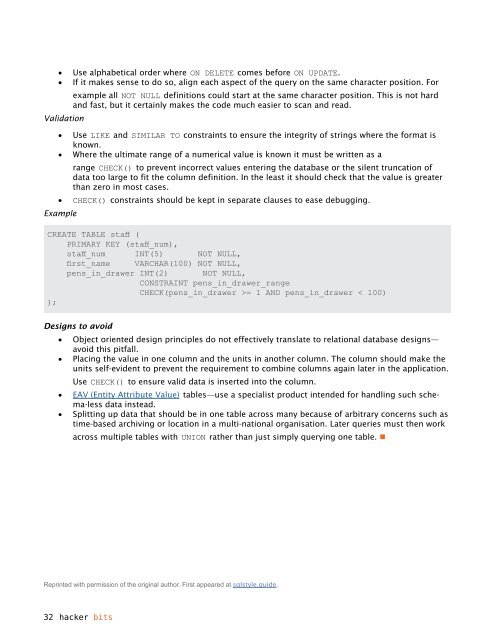Hacker Bits, Issue 11
HACKER BITS is the monthly magazine that gives you the hottest technology stories crowdsourced by the readers of Hacker News. We select from the top voted stories and publish them in an easy-to-read magazine format. Get HACKER BITS delivered to your inbox every month! For more, visit https://hackerbits.com/issue11.
HACKER BITS is the monthly magazine that gives you the hottest technology stories crowdsourced by the readers of Hacker News. We select from the top voted stories and publish them in an easy-to-read magazine format.
Get HACKER BITS delivered to your inbox every month! For more, visit https://hackerbits.com/issue11.
You also want an ePaper? Increase the reach of your titles
YUMPU automatically turns print PDFs into web optimized ePapers that Google loves.
• Use alphabetical order where ON DELETE comes before ON UPDATE.<br />
• If it makes sense to do so, align each aspect of the query on the same character position. For<br />
Validation<br />
example all NOT NULL definitions could start at the same character position. This is not hard<br />
and fast, but it certainly makes the code much easier to scan and read.<br />
• Use LIKE and SIMILAR TO constraints to ensure the integrity of strings where the format is<br />
known.<br />
• Where the ultimate range of a numerical value is known it must be written as a<br />
range CHECK() to prevent incorrect values entering the database or the silent truncation of<br />
data too large to fit the column definition. In the least it should check that the value is greater<br />
than zero in most cases.<br />
• CHECK() constraints should be kept in separate clauses to ease debugging.<br />
Example<br />
CREATE TABLE staff (<br />
PRIMARY KEY (staff_num),<br />
staff_num INT(5) NOT NULL,<br />
first_name VARCHAR(100) NOT NULL,<br />
pens_in_drawer INT(2) NOT NULL,<br />
CONSTRAINT pens_in_drawer_range<br />
CHECK(pens_in_drawer >= 1 AND pens_in_drawer < 100)<br />
);<br />
Designs to avoid<br />
• Object oriented design principles do not effectively translate to relational database designs—<br />
avoid this pitfall.<br />
• Placing the value in one column and the units in another column. The column should make the<br />
units self-evident to prevent the requirement to combine columns again later in the application.<br />
Use CHECK() to ensure valid data is inserted into the column.<br />
• EAV (Entity Attribute Value) tables—use a specialist product intended for handling such schema-less<br />
data instead.<br />
• Splitting up data that should be in one table across many because of arbitrary concerns such as<br />
time-based archiving or location in a multi-national organisation. Later queries must then work<br />
across multiple tables with UNION rather than just simply querying one table. •<br />
Reprinted with permission of the original author. First appeared at sqlstyle.guide.<br />
32 hacker bits















